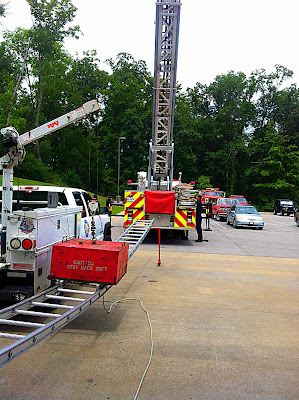Firefighters
are expected to perform under a variety of situations and immense stress. They
are also expected to do their job perfectly every time. The equipment that
firefighters depend on is no different. Both firefighters and their equipment
are subjected to annual tests and assessments to ensure that both are in the
right shape to perform their duties.
Recently, all of BFR’s ladders were put through their paces by an
independent company that specializes in fire service ladder testing.
The ladder testing system is confined to the bed of a utility truck
making it easy to set up and simple to operate.
The technician fills the red container up with water until it reaches a
specified weight.
The technician then lowers the container onto a ladder that spans two
saw horses, where it is then left for a specified time. Both the weight of the container and the
duration of the test depend on the size of the ladder. Prior to the ladder
being placed on the saw horses it is fully extended and retraced before being
inspected for physical defects. Once on the saw horses, the distance from the
ground to the middle of the ladder is measured and recorded. At the end of the
proscribed time, this distance is again measured. If a ladder does not return
to nearly the same measurement as before the weight was applied, it may be
failed.
While the ladder is being tested the technician
fills out the appropriate paperwork and records any irregular findings. These
records allow BFR to monitor changes to the equipment over time. Some examples
of the data being recorded include age and brand of ladder, if a particular
brand or type of ladder seems to be experiencing more issues than another or if
a particular apparatus is going through equipment at an accelerated rate.
Once a ladder passes the “stress test” the technician
will apply new heat exposure stickers.
These stickers are placed along the beams of all ladders. If the ladder has been exposed to an
excessive amount of heat, the dot in the middle of the sticker will turn
black. Firefighters examine these
stickers after every fire and take any ladder that has a black dot out of
service. Excessive heat can weaken a
ladder and make it unsafe for firefighters to use.
Pictured here is the 40’ Bangor ladder off L1. While the ladder may look like it’s about to
snap under all that weight its actually doing what it’s supposed to do. Aluminum ladders are designed to be
relatively lightweight and bend under stress instead of snapping and failing
instantly. These ladders are designed to support the weight of both a
firefighter and someone in need of rescue; they are much more robust than the
average ladder found at a hardware store.
Even the smallest of ladders have to be put through this rigorous
assessment. Pictured here is a foldable
attic ladder.
L1 and E3’s aerial ladders are put through 2
types of tests. In the first test the
ladder is extended to its maximum height and then the apparatus is shut
off. This test determines if the
hydraulic system is losing pressure and causing the ladder to retract or lower
on its own.
In the second test the ladder is extended out horizontally and weight
is applied to the very end. The
technician then looks for any excessive “give” that may indicate the ladder is
not able to hold the weight it may see on the fire ground.
At the end of a day of ladder testing, any
ladder that failed is taken out of service and replaced. BFR’s ladders that passed
their annual examination are re-certified and put back on their apparatus for
use on the next incident!








